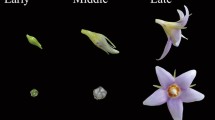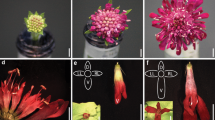Abstract
Dorsoventral asymmetry in flowers is thought to have evolved many times from a radially symmetrical ancestral condition. The first gene controlling floral asymmetry, cycloidea in Antirrhinum, has been isolated. The cycloidea gene is expressed at a very early stage in dorsal regions of floral meristems, where it affects growth rate and primordium initiation. Expression continues through to later stages in dorsal primordia to affect the asymmetry, size and cell types of petals and stamens.
Similar content being viewed by others
References
Coen, E. S. & Nugent, J. M. Development (suppl.) 107–116 (1994).
Coen, E. S. & Meyerowitz, E. M. Nature 353, 31–37 (1991).
Weigel, D. & Meyerowitz, E. M. Cell 78, 203–209 (1994).
Coen, E. S. Annu. Rev. Pl. Physiol. Pl. Mol. Biol. 42, 241–279 (1991).
Linnaeus, C. De Peloria. Diss. (Amoenitates Acad., Uppsala, 1749).
Carpenter, R. & Coen, E. S. Genes Dev. 4, 1483–1493 (1990).
Vincent, C., Carpenter, R. & Coen, E. S. Curr. Biol. 5, 1449–1458 (1995).
Carpenter, R. et al. Pl. Cell 7, 2001–2011 (1995).
Bonas, U., Sommer, H. & Saedler, H. EMBO J. 3, 1015–1019 (1984).
Krebbers, E. et al. Mol. Gen. Genet. 209, 499–507 (1987).
Somer, H. et al. in Plant Transposable Elements (ed. Nelson, O. E.) 227–235 (Plenum, New York, 1988).
Luo, D., Coen, E. S., Doyle, S. & Carpenter, R. Plant J. 1, 59–69 (1991).
Dingwall, C. & Laskey, R. A. Trends Biochem. Sci. 16, 478–481 (1991).
Kuckuck, H. & Schick, R. Z. f. indukt. Abst.-u. Vererbungsl. 56, 51–83 (1930).
Stubbe, H. Genetik und Zytologie von Antirrhinum L. sect. Antirrhinum (Frischer, Jena, 1966).
Running, M. P. & Meyerowitz, E. M. Development 122, 1261–1269 (1996).
Sommer, H. et al. EMBO J. 9, 605–613 (1990).
Bradley, D., Carpenter, R., Sommer, J., Hartley, N. & Coen, E. S. Cell 72, 85–95 (1993).
Tucker, S. in Contemporary Problems in Plant Anatomy (eds White, R. A. & Kickison, W. C.) 351–395 (Academic, London, 1984).
Carpenter, R., Martin, C. & Coen, E. S. Mol. Gen. Genet. 207, 82–89 (1987).
Hammer, K., Knüpffer, H. Kulturpflanze 38, 91–117 (1990).
Simon, R., Carpenter, R., Doyle, S. & Coen, E. S. Cell 78, 99–107 (1994).
Coen, E. et al. Cell 63, 1311–1322 (1990).
Author information
Authors and Affiliations
Rights and permissions
About this article
Cite this article
Luo, D., Carpenter, R., Vincent, C. et al. Origin of floral asymmetry in Antirrhinum. Nature 383, 794–799 (1996). https://doi.org/10.1038/383794a0
Received:
Accepted:
Issue Date:
DOI: https://doi.org/10.1038/383794a0
- Springer Nature Limited
This article is cited by
-
Sweet cherry TCP gene family analysis reveals potential functions of PavTCP1, PavTCP2 and PavTCP3 in fruit light responses
BMC Genomics (2024)
-
Genome-wide identification and integrated analysis of TCP genes controlling ginsenoside biosynthesis in Panax ginseng
BMC Plant Biology (2024)
-
Comparative floral development in Mimosa (Fabaceae: Caesalpinioideae) brings new insights into merism lability in the mimosoid clade
Journal of Plant Research (2024)
-
A BLADE-ON-PETIOLE orthologue regulates corolla differentiation in the proximal region in Torenia fournieri
Nature Communications (2023)
-
Arabidopsis TCP4 transcription factor inhibits high temperature-induced homeotic conversion of ovules
Nature Communications (2023)





